基於Spring MVC框架的Http流程分析
一、問題提出
我們可以方便的利用Spring MVC進行業務開發,請求的大部分工作都被框架和容器封裝,使得我們只需要做很少量的工作。但是整個http請求流程是怎麼樣的?Spring MVC框架在其中起到什麼作用?它是怎麼和Web容器進行互動的?Controller中的一個方法怎麼被暴露出來提供http請求服務的?本著這些想法,我們對整個http請求過程進行討索。全文以spring-mvc-demo為例
二、整體處理流程概述
整個過程包括三部分:應用啟動、請求路由與處理、請求返回。
應用啟動:web容器初始化(context建立等)、應用初始化(初始化handlerMap)。
請求路由與處理:請求路由(根據url找到Context、根據context找到dispatcherServlet、根據url找到handler、根據url找到handler的方法)、method反射呼叫獲取ModelAndView。
請求返回:邏輯檢視到物理檢視的轉換、物理檢視的渲染、檢視返回。
具體流程如下:
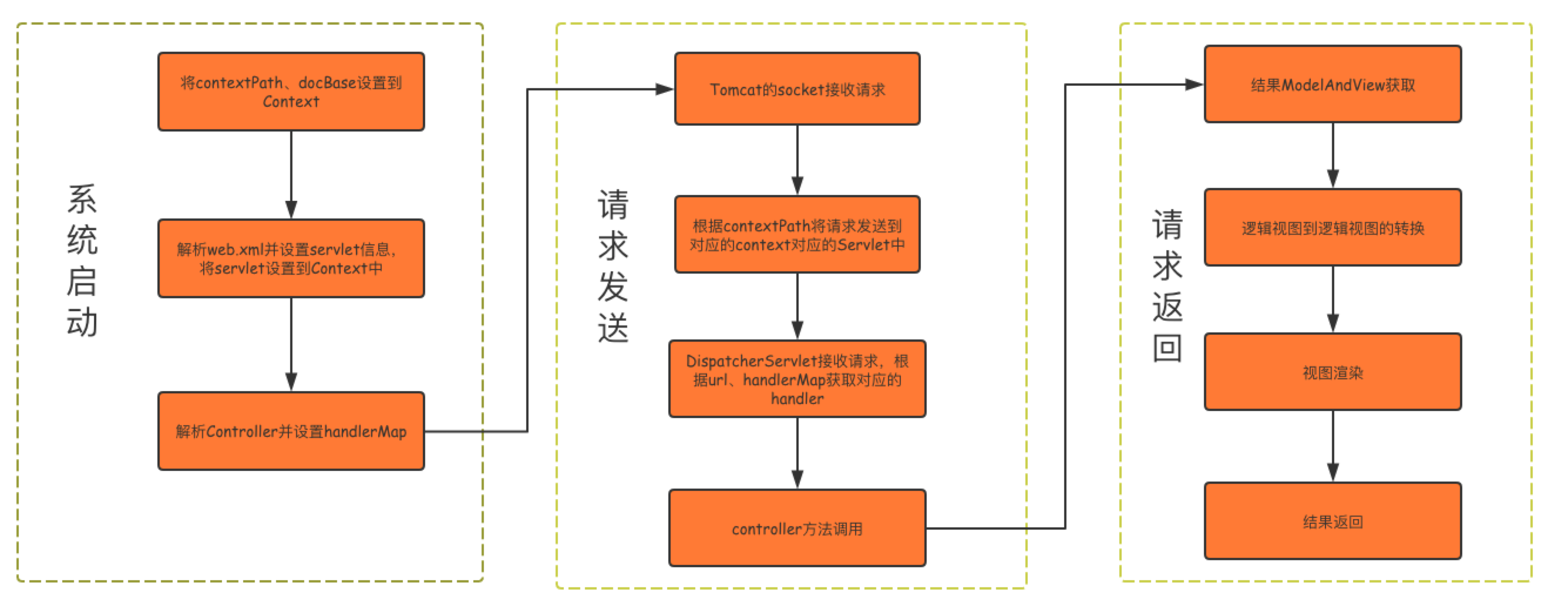
系統啟動:
1、web容器自己去將contextPath、docBase設定到一個context裡面,這裡面的一個context就是對應一個web應用。
2、web容器會根據docBase的值去獲取web.xml,並解析它來獲取servlet資訊,並設定web容器啟動完畢的監聽器。
3、web容器啟動後,會觸發spring mvc容器的啟動,spring mvc容器啟動時,會解析controller,並將@RequestMapping、@GetMapping、@PostMapping的值設定到handlerMap中,方便後續請求路由。
請求傳送:
1、外部發送請求(http://localhost:8080/spring-mvc-demo/user/register)時,請求會被轉發到web容器(這裡以tomcat為例),實際上就是tomcat與客戶端建立了socket連結。
2、根據url,tomcat會對應的host,host找到context,context找到對應的servlet(這裡為dispatcherServlet)。
3、dispatcherServlet會根據url,在handlerMap中去查到到對應的handler,然後將handler轉化為handlerAdapter。
4、AnnotationMethodHandlerAdapter會呼叫ServletHandlerMethodInvoker.invokeHandlerMethod方法,ServletHandlerMethodInvoker會通過反射的方式去呼叫controller的對應方法。
請求返回:
1、根據controller的返回,獲取對應的ModelAndView。
2、DispatcherServlet的resolveViewName方法會將邏輯檢視轉換為物理檢視。
3、org.springframework.web.servlet.view.AbstractView#render方法會進行檢視渲染工作,具體的渲染檢視為org.springframework.web.servlet.view.JstlView
4、jsp檔案會被編譯成一個servlet,然後,jspServlet會呼叫service方法,最後會將檢視寫到客戶端。
三、系統啟動
1、context設定
我們通過shell指令碼呼叫gradle的tomcatRun方法來啟動應用,然後在本地debug的方式來獲取執行引數。在org.apache.catalina.startup.Tomcat#addWebapp(org.apache.catalina.Host, java.lang.String, java.lang.String)的方法上打斷點,獲取資訊如下:
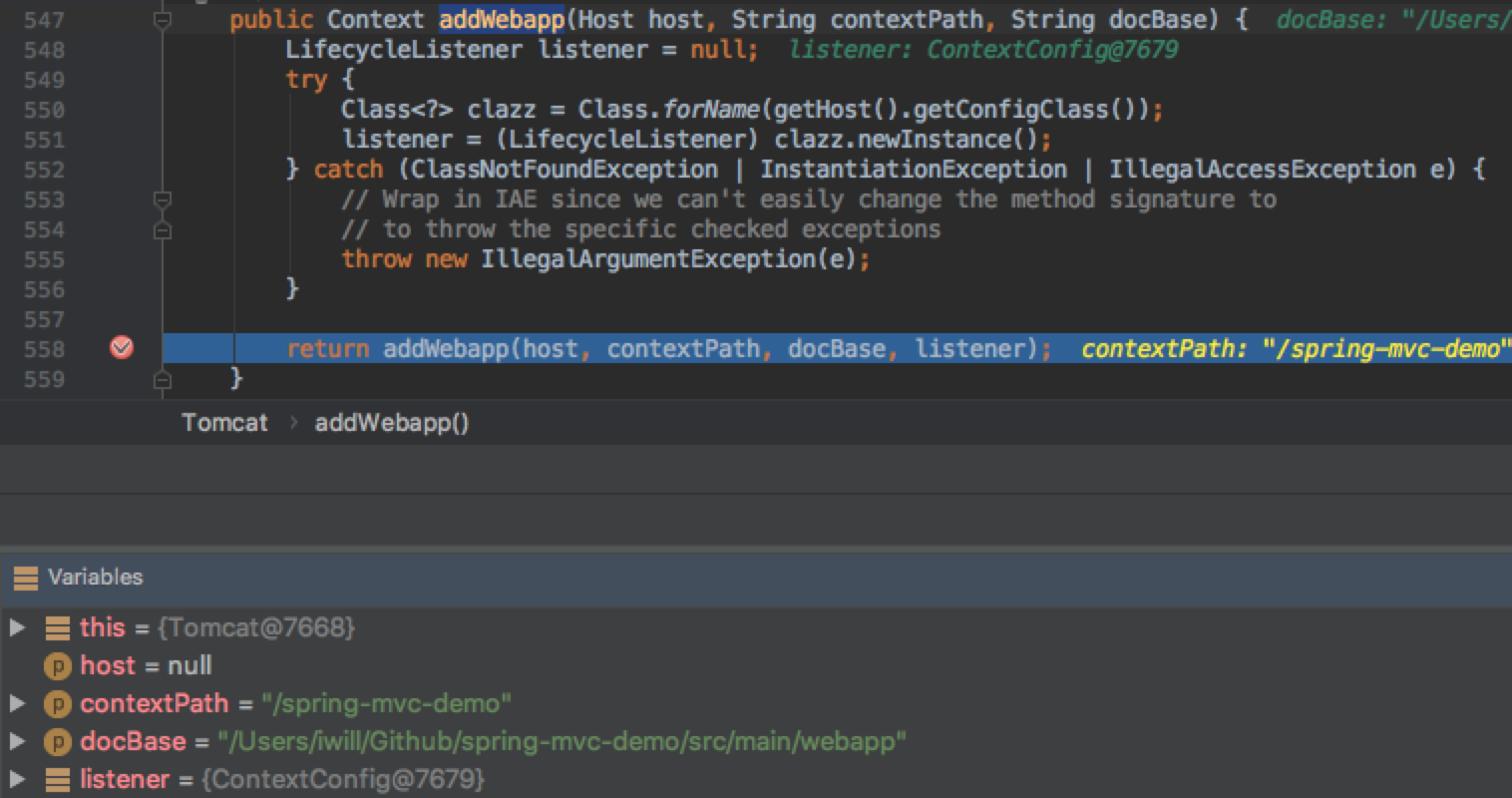
這裡的listener為ContextConfig,它會監聽容器相關事件,其中一項工作就是監聽tomcat啟動後去解析web.xml。也可以看出contextPath、docBase的值。
被呼叫的addWebapp方法就是初始化context,並將context新增到host中。具體如下:
public Context addWebapp(Host host, String contextPath, String docBase,
LifecycleListener config) {
silence(host, contextPath);
Context ctx = createContext(host, contextPath);
ctx.setPath(contextPath);
ctx.setDocBase(docBase);
ctx.addLifecycleListener(new DefaultWebXmlListener());
ctx.setConfigFile(getWebappConfigFile(docBase, contextPath));
ctx.addLifecycleListener(config);
if (config instanceof ContextConfig) {
// prevent it from looking ( if it finds one - it'll have dup error )
((ContextConfig) config).setDefaultWebXml(noDefaultWebXmlPath());
}
if (host == null) {
getHost().addChild(ctx);
} else {
host.addChild(ctx);
}
return ctx;
}2、context中servlet設定
通過在ContextConfig的lifecycleEvent方法是監聽系統事件的入口:
public void lifecycleEvent(LifecycleEvent event) {
// Identify the context we are associated with
try {
context = (Context) event.getLifecycle();
} catch (ClassCastException e) {
log.error(sm.getString("contextConfig.cce", event.getLifecycle()), e);
return;
}
// Process the event that has occurred
if (event.getType().equals(Lifecycle.CONFIGURE_START_EVENT)) {
configureStart();
} else if (event.getType().equals(Lifecycle.BEFORE_START_EVENT)) {
beforeStart();
} else if (event.getType().equals(Lifecycle.AFTER_START_EVENT)) {
// Restore docBase for management tools
if (originalDocBase != null) {
context.setDocBase(originalDocBase);
}
} else if (event.getType().equals(Lifecycle.CONFIGURE_STOP_EVENT)) {
configureStop();
} else if (event.getType().equals(Lifecycle.AFTER_INIT_EVENT)) {
init();
} else if (event.getType().equals(Lifecycle.AFTER_DESTROY_EVENT)) {
destroy();
}
}通過在這個方法上打斷點,在監聽到after_init事件後,我們可以看到context的servletMappings的值如下:

對照web.xml的配置:
<?xml version="1.0" encoding="UTF-8"?>
<web-app version="2.5" xmlns="http://java.sun.com/xml/ns/javaee"
xmlns:xsi="http://www.w3.org/2001/XMLSchema-instance"
xsi:schemaLocation="http://java.sun.com/xml/ns/javaee
http://java.sun.com/xml/ns/javaee/web-app_2_5.xsd">
<context-param>
<param-name>contextConfigLocation</param-name>
<param-value>classpath:/applicationContext.xml</param-value>
</context-param>
<listener>
<listener-class>org.springframework.web.context.ContextLoaderListener</listener-class>
</listener>
<servlet>
<servlet-name>smart</servlet-name>
<servlet-class>org.springframework.web.servlet.DispatcherServlet</servlet-class>
<load-on-startup>1</load-on-startup>
</servlet>
<servlet-mapping>
<servlet-name>smart</servlet-name>
<url-pattern>/</url-pattern>
</servlet-mapping>
<welcome-file-list>
<welcome-file>index.jsp</welcome-file>
</welcome-file-list>
</web-app>
可以看到,DispatcherServlet被載入到context中,因此,該context中的“/”請求會被分配給DispatcherServlet處理。
3、handlerMap初始化
在org.springframework.web.servlet.handler.AbstractDetectingUrlHandlerMapping#detectHandlers上打斷點,我們可以看見org.springframework.web.servlet.handler.BeanNameUrlHandlerMapping和org.springframework.web.servlet.mvc.annotation.DefaultAnnotationHandlerMapping會被用來檢測handler。
其中BeanNameUrlHandlerMapping的檢測方式如下:
protected String[] determineUrlsForHandler(String beanName) {
List<String> urls = new ArrayList<String>();
if (beanName.startsWith("/")) {
urls.add(beanName);
}
String[] aliases = getApplicationContext().getAliases(beanName);
for (String alias : aliases) {
if (alias.startsWith("/")) {
urls.add(alias);
}
}
return StringUtils.toStringArray(urls);
}它會檢測到如下型別的handler
@Controller("/person")
public class PersonController{}DefaultAnnotationHandlerMapping的檢測方式如下:
@Override
protected String[] determineUrlsForHandler(String beanName) {
ApplicationContext context = getApplicationContext();
Class<?> handlerType = context.getType(beanName);
RequestMapping mapping = context.findAnnotationOnBean(beanName, RequestMapping.class);
if (mapping != null) {
// @RequestMapping found at type level
this.cachedMappings.put(handlerType, mapping);
Set<String> urls = new LinkedHashSet<String>();
String[] typeLevelPatterns = mapping.value();
if (typeLevelPatterns.length > 0) {
// @RequestMapping specifies paths at type level
String[] methodLevelPatterns = determineUrlsForHandlerMethods(handlerType, true);
for (String typeLevelPattern : typeLevelPatterns) {
if (!typeLevelPattern.startsWith("/")) {
typeLevelPattern = "/" + typeLevelPattern;
}
boolean hasEmptyMethodLevelMappings = false;
for (String methodLevelPattern : methodLevelPatterns) {
if (methodLevelPattern == null) {
hasEmptyMethodLevelMappings = true;
}
else {
String combinedPattern = getPathMatcher().combine(typeLevelPattern, methodLevelPattern);
addUrlsForPath(urls, combinedPattern);
}
}
if (hasEmptyMethodLevelMappings ||
org.springframework.web.servlet.mvc.Controller.class.isAssignableFrom(handlerType)) {
addUrlsForPath(urls, typeLevelPattern);
}
}
return StringUtils.toStringArray(urls);
}
else {
// actual paths specified by @RequestMapping at method level
return determineUrlsForHandlerMethods(handlerType, false);
}
}
else if (AnnotationUtils.findAnnotation(handlerType, Controller.class) != null) {
// @RequestMapping to be introspected at method level
return determineUrlsForHandlerMethods(handlerType, false);
}
else {
return null;
}
}即根據@RequestMapping來檢測url,檢測到url後,會將url為key,對應的controller為value放到handlerMap中。
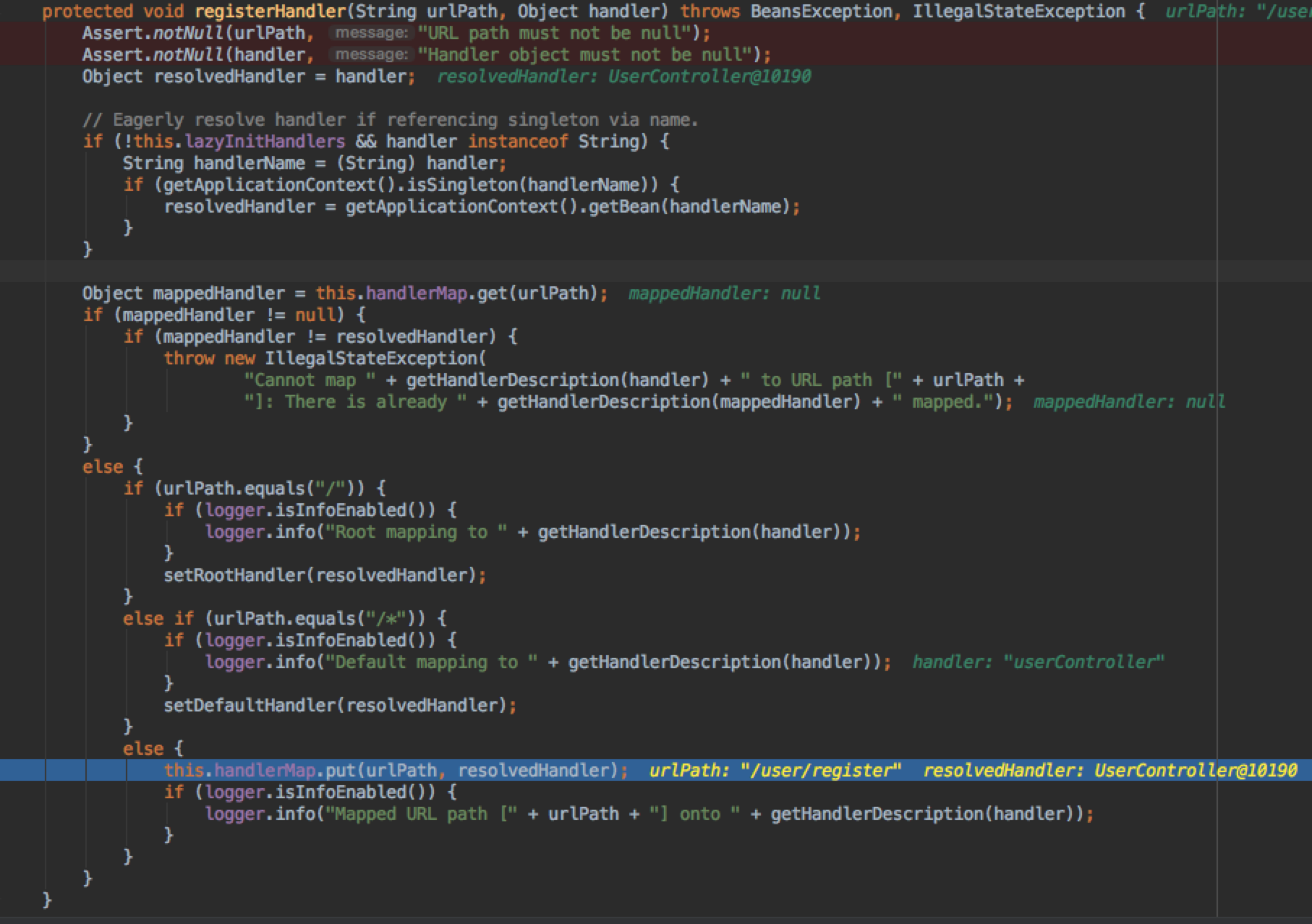
四、請求傳送
1、請求context獲取
在org.apache.catalina.mapper.Mapper#internalMap方法中,會根據url去查詢host和context。

這裡的host為localhost,根據這個去hosts列表中查詢對應的host。

再在查詢到的host的contextlist中去查詢context。找到後,會將context的資訊設定到mappingData
2、servlet獲取
獲取到context後,在根據請求url以及context中的servletMapping就可以得到對應的servlet,之後就會呼叫對應的servlet的service方法。以請求http://localhost:8080/spring-mvc-demo/user/register(get方法)為例,會呼叫org.springframework.web.servlet.FrameworkServlet#doGet方法,順著流程,就會走到DispatcherServlet的doDispatch方法了。
protected void doService(HttpServletRequest request, HttpServletResponse response) throws Exception {
if (logger.isDebugEnabled()) {
String requestUri = urlPathHelper.getRequestUri(request);
String resumed = WebAsyncUtils.getAsyncManager(request).hasConcurrentResult() ? " resumed" : "";
logger.debug("DispatcherServlet with name '" + getServletName() + "'" + resumed +
" processing " + request.getMethod() + " request for [" + requestUri + "]");
}
// Keep a snapshot of the request attributes in case of an include,
// to be able to restore the original attributes after the include.
Map<String, Object> attributesSnapshot = null;
if (WebUtils.isIncludeRequest(request)) {
logger.debug("Taking snapshot of request attributes before include");
attributesSnapshot = new HashMap<String, Object>();
Enumeration<?> attrNames = request.getAttributeNames();
while (attrNames.hasMoreElements()) {
String attrName = (String) attrNames.nextElement();
if (this.cleanupAfterInclude || attrName.startsWith("org.springframework.web.servlet")) {
attributesSnapshot.put(attrName, request.getAttribute(attrName));
}
}
}
// Make framework objects available to handlers and view objects.
request.setAttribute(WEB_APPLICATION_CONTEXT_ATTRIBUTE, getWebApplicationContext());
request.setAttribute(LOCALE_RESOLVER_ATTRIBUTE, this.localeResolver);
request.setAttribute(THEME_RESOLVER_ATTRIBUTE, this.themeResolver);
request.setAttribute(THEME_SOURCE_ATTRIBUTE, getThemeSource());
FlashMap inputFlashMap = this.flashMapManager.retrieveAndUpdate(request, response);
if (inputFlashMap != null) {
request.setAttribute(INPUT_FLASH_MAP_ATTRIBUTE, Collections.unmodifiableMap(inputFlashMap));
}
request.setAttribute(OUTPUT_FLASH_MAP_ATTRIBUTE, new FlashMap());
request.setAttribute(FLASH_MAP_MANAGER_ATTRIBUTE, this.flashMapManager);
try {
doDispatch(request, response);
}
finally {
if (WebAsyncUtils.getAsyncManager(request).isConcurrentHandlingStarted()) {
return;
}
// Restore the original attribute snapshot, in case of an include.
if (attributesSnapshot != null) {
restoreAttributesAfterInclude(request, attributesSnapshot);
}
}
}3、handler獲取
在前文說過,handler會被放到handlerMap中,key為請求的url。

請求處理已經在《Spring MVC請求處理流程分析》說過,就不再詳述了。
五、請求返回
檢視渲染在方法:org.springframework.web.servlet.DispatcherServlet#render中進行,具體如下:
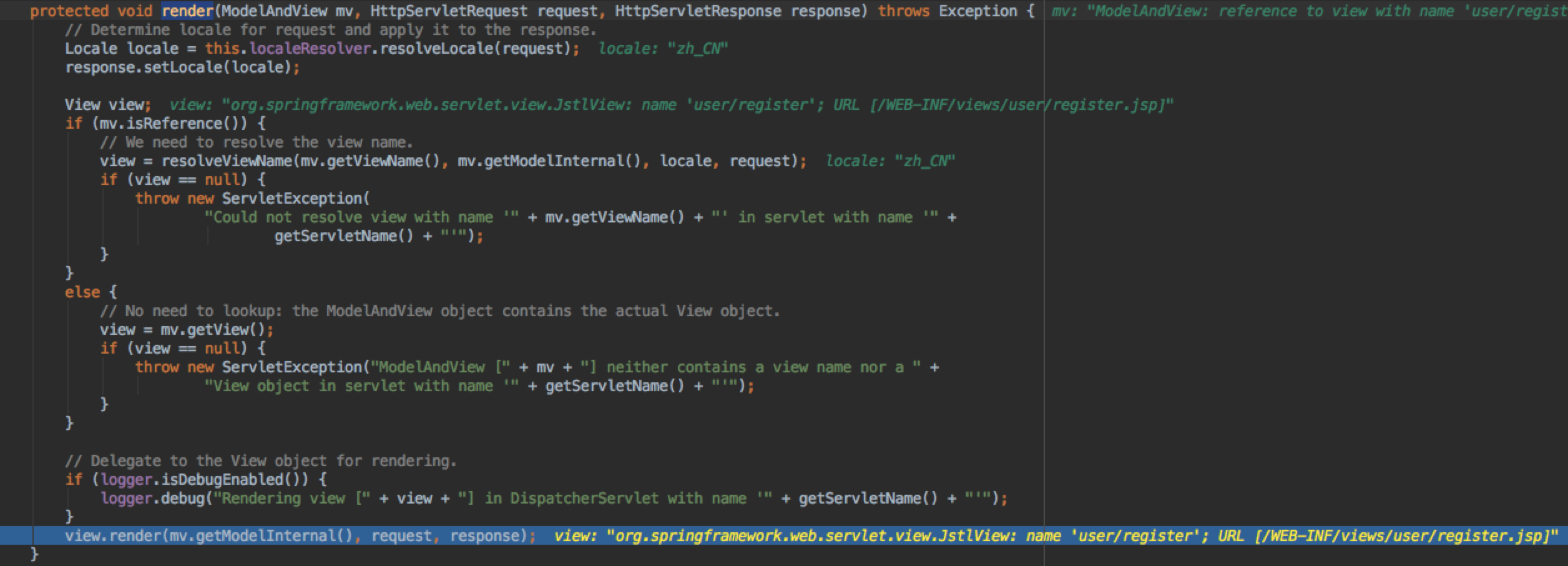
我們配置的檢視為:org.springframework.web.servlet.view.JstlView,它會將檢視渲染後,然後,通過JspServlet的service方法將檢視通過writer.out輸出到客戶端。
我們開啟register_jsp.java檔案,其所在目錄如下:
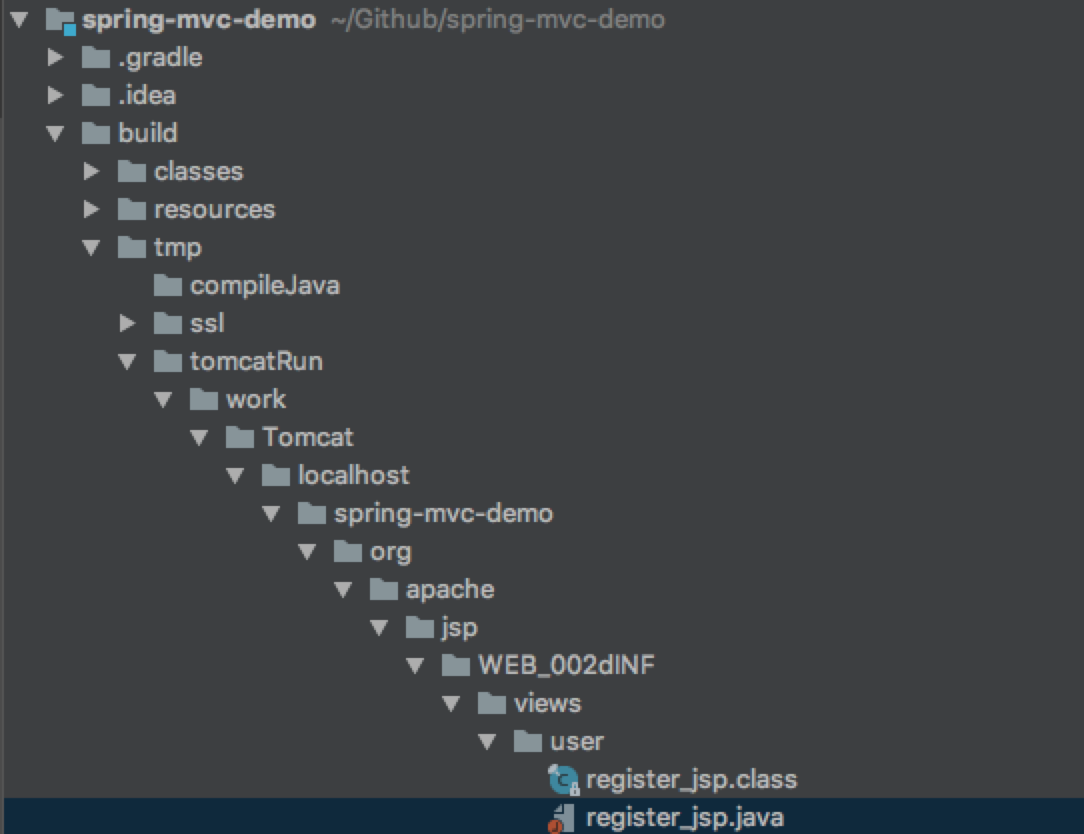
其service方法內容如下:
public void _jspService(final javax.servlet.http.HttpServletRequest request, final javax.servlet.http.HttpServletResponse response)
throws java.io.IOException, javax.servlet.ServletException {
final java.lang.String _jspx_method = request.getMethod();
if (!"GET".equals(_jspx_method) && !"POST".equals(_jspx_method) && !"HEAD".equals(_jspx_method) && !javax.servlet.DispatcherType.ERROR.equals(request.getDispatcherType())) {
response.sendError(HttpServletResponse.SC_METHOD_NOT_ALLOWED, "JSPs only permit GET POST or HEAD");
return;
}
final javax.servlet.jsp.PageContext pageContext;
javax.servlet.http.HttpSession session = null;
final javax.servlet.ServletContext application;
final javax.servlet.ServletConfig config;
javax.servlet.jsp.JspWriter out = null;
final java.lang.Object page = this;
javax.servlet.jsp.JspWriter _jspx_out = null;
javax.servlet.jsp.PageContext _jspx_page_context = null;
try {
response.setContentType("text/html; charset=UTF-8");
pageContext = _jspxFactory.getPageContext(this, request, response,
null, true, 8192, true);
_jspx_page_context = pageContext;
application = pageContext.getServletContext();
config = pageContext.getServletConfig();
session = pageContext.getSession();
out = pageContext.getOut();
_jspx_out = out;
out.write("\n");
out.write("\n");
out.write("\n");
out.write("<html>\n");
out.write("<head>\n");
out.write(" <title>新增使用者</title>\n");
out.write("</head>\n");
out.write("<body>\n");
out.write("<form method=\"post\" action=\"");
if (_jspx_meth_c_005furl_005f0(_jspx_page_context))
return;
out.write("\">\n");
out.write(" <table>\n");
out.write(" <tr>\n");
out.write(" <td>使用者名稱:</td>\n");
out.write(" <td><input type=\"text\" name=\"userName\" value=\"");
out.write((java.lang.String) org.apache.jasper.runtime.PageContextImpl.proprietaryEvaluate("${user.userName}", java.lang.String.class, (javax.servlet.jsp.PageContext)_jspx_page_context, null));
out.write("\"/></td>\n");
out.write(" </tr>\n");
out.write(" <tr>\n");
out.write(" <td>密碼:</td>\n");
out.write(" <td><input type=\"password\" name=\"password\" value=\"");
out.write((java.lang.String) org.apache.jasper.runtime.PageContextImpl.proprietaryEvaluate("${user.password}", java.lang.String.class, (javax.servlet.jsp.PageContext)_jspx_page_context, null));
out.write("\"/></td>\n");
out.write(" </tr>\n");
out.write(" <tr>\n");
out.write(" <td>姓名:</td>\n");
out.write(" <td><input type=\"text\" name=\"realName\" value=\"");
out.write((java.lang.String) org.apache.jasper.runtime.PageContextImpl.proprietaryEvaluate("${user.realName}", java.lang.String.class, (javax.servlet.jsp.PageContext)_jspx_page_context, null));
out.write("\"/></td>\n");
out.write(" </tr>\n");
out.write(" <tr>\n");
out.write(" <td colspan=\"2\"><input type=\"submit\" name=\"提交\"/></td>\n");
out.write(" </tr>\n");
out.write(" </table>\n");
out.write("</form>\n");
out.write("</body>\n");
out.write("</html>");
} catch (java.lang.Throwable t) {
if (!(t instanceof javax.servlet.jsp.SkipPageException)){
out = _jspx_out;
if (out != null && out.getBufferSize() != 0)
try {
if (response.isCommitted()) {
out.flush();
} else {
out.clearBuffer();
}
} catch (java.io.IOException e) {}
if (_jspx_page_context != null) _jspx_page_context.handlePageException(t);
else throw new ServletException(t);
}
} finally {
_jspxFactory.releasePageContext(_jspx_page_context);
}
}
因此,我們可以猜測,register.jsp被渲染後,通過writer.out方法將檢視輸
